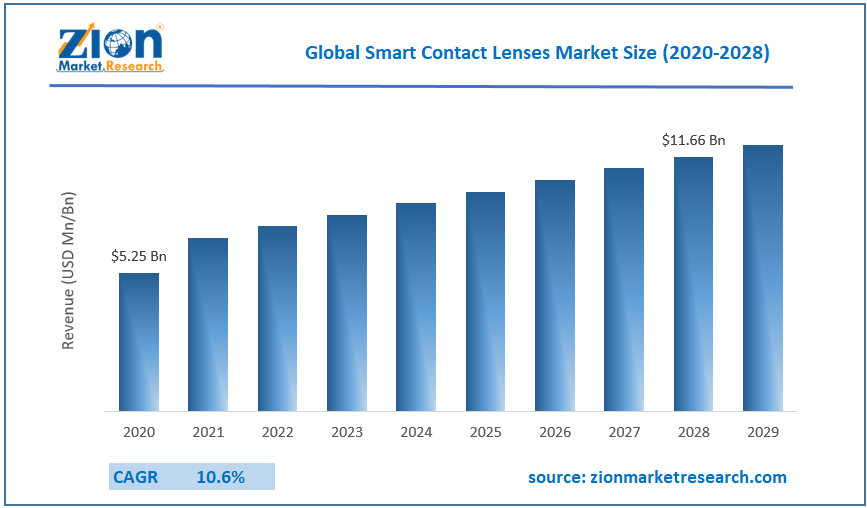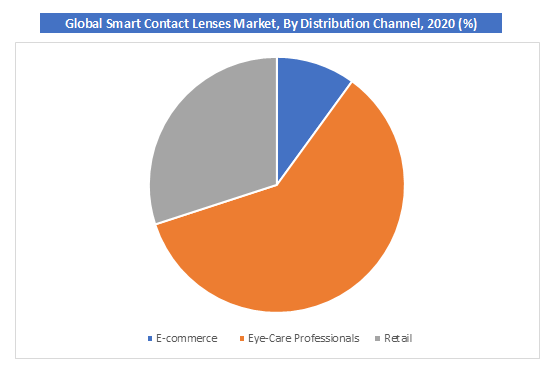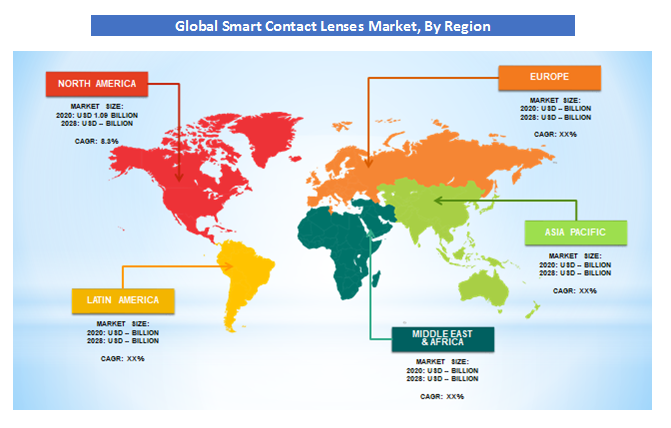Smart Contact Lenses Market Size, Share, Growth Analysis, 2028

Smart Contact Lenses Market - By Material (Gas Permeable, Silicone Hydrogel, and Hybrid), By Type (Continuous Glucose Monitoring, Intraocular Pressure Monitoring and Others), By Distribution Channel (E-Commerce, Eye-Care Professionals, and Retail): Global Industry Perspective, Comprehensive Analysis, and Forecast, 2020 - 2028
| Market Size in 2020 | Market Forecast in 2028 | CAGR (in %) | Base Year |
|---|---|---|---|
| USD 5.25 Billion | USD 11.66 Billion | 10.6% | 2020 |
Smart Contact Lenses Market Size And Overview
The Global Smart Contact Lenses Market size accounted for USD 5.25 Billion in 2020 and is expected to reach USD 11.66 Billion by 2028, growing at a CAGR of 10.6% from 2021 to 2028.
Smart Contact Lenses are used to monitor glucose levels in tears as well as intraocular pressure. The glucose sensor and wireless chip in the smart lens are positioned between the soft layers of lenses with a tiny hole, allowing tear flow for measurement and data collecting. The wireless chip transmits signals to wireless devices using acquired data, and RFID wireless technology is utilized to extract power from these devices. It is frequently used as a healthcare solution for diabetes people who want to check their fitness level and monitor their blood pressure, body temperature, and cholesterol levels.
COVID-19 Impact Analysis
With the advent of COVID-19, there has been a rise in worries about wearing contact lenses since they involve touching the eyes, which might lead to infection with COVID-19. Despite the lack of proof that COVID-19 is transferred through contact lenses, numerous healthcare organizations recommended temporarily switching to avoid these smart contact lenses. Due to global lockdown measures, optometric clinics and retail establishments were forced to shutter or operate with inadequate resources, disrupting the distribution route. During the lockdown, many individuals worked from home or did not sleep out, reducing the use of smart contact lenses.
Growth Factors
One of the major growth drivers for the Global Smart Contact Lenses Market is the Rising Prevalence of Diabetes will Propel Market Growth. The rising prevalence of diabetes and glaucoma is fuelling the growth of the smart contact lenses market. Since the previous decade, contact lenses have advanced significantly in the area of optometry, gaining impetus as a result of fast breakthroughs in the profession. The ability of smart contact lenses to identify ailments such as diabetes and glaucoma is improving the total industry. Smart lenses also have additional functions, such as automated adjustment to light and dark situations and capturing images, and are in great demand among individuals with age-related macular degeneration (AMD) and other health-related difficulties.
Another factor for the growth in this market is an increase in research and development in the field of contact lenses. Contact lenses are one of the fastest-growing fields in optometry, with a number of notable advancements in this sector over the previous decade. Smart contact lenses are one of the most recent and significant advancements in contact lens technology. These cutting-edge lenses can detect diabetes, glaucoma, and other health issues in a matter of seconds. In addition, prominent firms are working on the creation of smart contact lenses that will allow individuals to capture images with their eyes and respond to changing light in the environment for clear vision as the light changes. People with age-related macular degeneration and other difficulties will benefit from this. This market's expansion is due to such research and development initiatives.
Smart Contact Lenses Market Report Scope:
| Report Attributes | Report Details |
|---|---|
| Report Name | Smart Contact Lenses Market Research Report |
| Market Size in 2020 | USD 5.25 Billion |
| Market Forecast in 2028 | USD 11.66 Billion |
| Compound Annual Growth Rate | CAGR of 10.6% |
| Number of Pages | 180 |
| Forecast Units | Value (USD Billion), and Volume (Units) |
| Key Companies Covered | Innovega Inc, Novartis AG, Samsung Electronics Co., Ltd., Google Inc., Sensimed AG, Sony Corporation, Liner Technologies, EP Global Communications, Inc., Analog Devices, Knowles, InvenSense, NXP Semiconductor, Rockwell Automation, Banner Engineering, Atmel, Murata Manufacturing, Nanomix, Hitachi, TOWA, STMicroelectronics, and Texas Instruments. |
| Segments Covered | By Type, By Material, By Distribution Channel, And By Region |
| Regions Covered | North America, Europe, Asia Pacific (APAC), Latin America, Middle East, and Africa (MEA) |
| Countries Covered | North America: U.S and Canada Europe: Germany, Italy, Russia, U.K, Spain, France, Rest of Europe APAC: China, Australia, Japan, India, South Korea, South East Asia, Rest of Asia Pacific Latin America: Brazil, Argentina, Chile The Middle East And Africa: South Africa, GCC, Rest of MEA |
| Base Year | 2021 |
| Historical Year | 2017 to 2021 |
| Forecast Year | 2022 - 2030 |
| Customization Scope | Avail customized purchase options to meet your exact research needs. Request For Customization |
Material Segment Analysis Preview
The market is divided into three types of materials: gas permeable, silicone hydrogel, and hybrid. Over the projected period, the hybrid lens category is predicted to increase significantly. A hybrid lens combines gas-permeable and silicone hydrogel materials. It comprises of an RGP center zone surrounded by a soft or silicone hydrogel material peripheral skirt. It combines the softness of a soft lens with the optical clarity of an RGP lens. People with astigmatism and keratoconus are projected to utilize hybrid lenses more frequently, which is likely to boost category development.
Distribution Channel Segment Analysis Preview
The market is divided into three categories based on the distribution channel: e-commerce, Eye-Care Professionals (ECP), and retail. Independent eye-care practitioners distribute the bulk of the lenses created. As a result, Internet shopping is predicted to have the least market share. As a result, market penetration in the ECP channel represents a significant profit opportunity. Contact lenses used to need daily removal and extensive cleaning procedures. Furthermore, consumers traditionally purchased eye lenses from eye practitioners; however, the introduction of disposable soft contact lenses that consumers wear for only a few weeks, as well as the advancement of non-practitioner lens sellers, such as e-commerce contact lens retailers, altered market dynamics. The e-commerce industry has simplified distribution and allowed firms to expand their geographic reach globally.
Regional Analysis Preview
North America has the highest share of the worldwide smart contact lenses market due to the rising incidence of diabetes and the rising desire for novel eye care solutions to combat health concerns. Wearable medical device use is increasing throughout all age groups, notably among the elderly, which is driving the segment's growth. The region's expansion is being fueled by current trends in the cosmetics industry.
Europe is one of the most promising areas in the worldwide market due to increased spending on research and development in smart medical devices. The increasing adoption of smart contact lenses in the nations propels regional market expansion even more.
Asia Pacific is a developing area in the global smart contact lenses market due to the rising incidence of chronic conditions such as diabetes in the area. With increased knowledge and technological improvements in the field, countries such as China and India are likely to rise considerably.
Key Market Players & Competitive Landscape
Some of the significant players in the global smart contact lenses market are
- Innovega Inc
- Novartis AG
- Samsung Electronics Co., Ltd.
- Google Inc.
- Sensimed AG
- Sony Corporation
- Liner Technologies
- EP Global Communications, Inc.
- Analog Devices
- Knowles
- InvenSense
- NXP Semiconductor
- Rockwell Automation
- Banner Engineering
- Atmel
- Murata Manufacturing
- Nanomix
- Hitachi
- TOWA
- STMicroelectronics
- Texas Instruments.
The Global Smart Contact Lenses Market is segmented as follows:
By Type
- Continuous Glucose Monitoring
- Intraocular Pressure Monitoring
- Others
By Material
- Gas Permeable
- Silicone Hydrogel
- Hybrid
By Distribution Channel
- E-Commerce
- Retail
- Eye-Care Professionals
By Region
- North America
- The U.S.
- Canada
- Europe
- France
- The UK
- Spain
- Germany
- Italy
- Rest of Europe
- Asia Pacific
- China
- Japan
- India
- South Korea
- Southeast Asia
- Rest of Asia Pacific
- Latin America
- Brazil
- Mexico
- Rest of Latin America
- Middle East & Africa
- GCC
- South Africa
- Rest of Middle East & Africa
Table Of Content
Methodology
FrequentlyAsked Questions
The Global Smart Contact Lenses Market was valued at USD 5.25 Billion in 2020.
Global Smart Contact Lenses Market is expected to reach USD 11.66 Billion by 2028, growing at a CAGR of 10.6% between 2021 to 2028.
Some of the key factors driving the Global Smart Contact Lenses Market growth are Rising Prevalence of Diabetes will Propel Market Growth and Increase of research and development in field of contact lens.
North America accounted for the largest share market segment with 8.3% CAGR in Global Smart Contact Lenses Market in 2020.
Some of key players in Global Smart Contact Lenses Market are Innovega Inc, Novartis AG, Samsung Electronics Co., Ltd., Google Inc., Sensimed AG, Sony Corporation, Liner Technologies, EP Global Communications, Inc., Analog Devices, Knowles, InvenSense, NXP Semiconductor, Rockwell Automation, Banner Engineering, Atmel, Murata Manufacturing, Nanomix, Hitachi, TOWA, STMicroelectronics, and Texas Instruments.
The term smart contact lenses refer to a sort of wearable technology that, in addition to correcting a person's vision, can provide a variety of other benefits by incorporating microscopic electronics and sensors inside contact lenses. Smart contact lenses have the ability to monitor and record health information such as blood sugar levels, and body temperature, and even detect early indicators of disorders such as glaucoma or cataracts. In addition, these contact lenses may be able to monitor and store this information.
The technology that goes into smart contact lenses can vary, but some designs integrate microprocessors, very small cameras, and wireless communication systems to enable the lenses to send data to a nearby device. Some types of intelligent contact lenses are powered by extremely small batteries, while others are able to gather energy from the wearer's own body, such as the heat produced by the eyeballs.
The creation of intelligent contact lenses is still in its early stages; however, ongoing research and testing are being performed to increase both the practicality and safety of these lenses. Even if they present interesting prospects for the future, there are still obstacles to be addressed, such as making sure that wearing contact lenses is not only comfortable but also does not irritate or otherwise harm the eyes.
Choose License Type
RelatedNews
HappyClients
Zion Market Research
Tel: +1 (302) 444-0166
USA/Canada Toll Free No.+1 (855) 465-4651
3rd Floor,
Mrunal Paradise, Opp Maharaja Hotel,
Pimple Gurav, Pune 411061,
Maharashtra, India
Phone No +91 7768 006 007, +91 7768 006 008
US OFFICE NO +1 (302) 444-0166
US/CAN TOLL FREE +1 (855) 465-4651
Email: sales@zionmarketresearch.com
We have secured system to process your transaction.
Our support available to help you 24 hours a day, five days a week.
Monday - Friday: 9AM - 6PM
Saturday - Sunday: Closed








